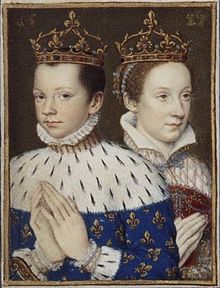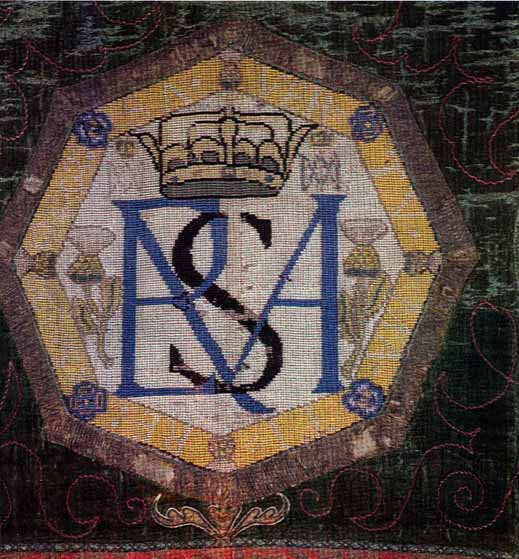a. morbid
b. gruesome
c. the only surefire way to know what a person looked like, pre-photography or
d. all of the above.
Answer? D - for 'duh,' obvs.
If this death mask, from the collection at Lennoxlove Castle in Scotland, represents the face of Mary Queen of Scots, it's no wonder she had a reputation as a beauty.
 |
| Death masks: a fun craft project to help take your mind off your grief. |
As her death was disgustingly disfiguring, it's curious to see no evidence of the initial axe-blow that was noted in some accounts of her execution to have crashed into the side of her face.
The years that led up to her execution are a goulash of royalty, privileged childhood, sweet temperament, beauty, trusting the wrong people, lack of critical thinking, impulsive decision-making, three marriages, a throne, trying to take another's throne, and years of boring house arrest followed by a botched (whether intentional or not) beheading.
Mary Queen of Scots was born a Princess on 8 December, 1542.
Six days later, her father, James V died.
.jpg/200px-Portrait_of_James_V_of_Scotland_(1512_-_1542).jpg) |
| James V, father of Mary Queen of Scots. Died before her umbilical cord dropped off. Poor kid. |
Bit young for ruling a country, don't you think?
With that in mind, her mother, Mary of Guise, acted as regent in place of the infant.
Little Mary was a beautiful child by all accounts.
As was the custom for children of royalty at that time, marriage plans were quickly laid for the lass.
While her elders dreamed of future alliances with other nations, cemented by marriages between the children of the rulers, Mary grew from infant to toddler.
By the time she was pre-K age, England came a'courting.
Henry VIII, always eager to fend off France in any way, shape or form possible, buffaloed his way into a marriage agreement between his son, Prince Edward and little Mary Queen of Scots.
Mary of Guise, not really on board with the deal, did a quick bait-and-switch; she bolted with her daughter to Stirling Castle.
| Good luck storming THOSE walls. Stirling Castle |
This time, though, the future groom was Henry II of France's son.
Mary Queen of Scots was sent to be raised in France, with her future husband, Francis the Dauphin of France, in 1548.
The pair were married in 1558;
 |
| Francis and Mary, the happy teen couple. |
She married again, this time, a distant cousin.
Lord Darnley, her new husband, had a personality not even a mother could love.
 |
| Lord Henry Darnley - a face everyone pretty much wanted to smack. |
After her child, James, was born, the tables turned and this time it was Lord Darnley who was murdered in a very suspicious 'accident.'
Mary Queen of Scots married again, within a short enough period of time to be considered disgraceful.
Her third husband was the Earl of Bothwell.
 |
| Earl of Bothwell - drawing from not a death mask, but his actual, mummified, gruesome remains. Pardon the retching. |
Hoping the Queen, her cousin Elizabeth, would give her shelter from the storm of her own making, the trusting and at-face-value Mary had walked in to captivity.
Elizabeth I, knowing full well Mary Queen of Scots had claim to the throne of England through both blood line and through the overwhelmingly Roman Catholic faith's dictates, kept Mary under house arrest.
Cleverly, Elizabeth I, never one to spend a farthing she didn't have to, made a mad house party of entertaining her cousin - at the expense of the unlucky hosts and hostesses who'd been unwillingly 'gifted' this expensive houseguest and all her servants, ladies, and her little dog, too.
Mary sat around, embroidering and partying with the lady of whichever manor in which she'd been ensconced.
For nineteen (19!!) years.
All the while, Elizabeth I spied on Mary through those loyal to her.
When Mary, bored to tears at all that embroidery work
 |
| Mary's embroidery. Sharpen your needles, ladies, and get ready for yet another fun day of stitching. Yawn. |
Oh, the delicious pain of going back and forth over 'do I execute her? do I not execute her? if my sister had acted without solid proof, Mary's fate would have been mine? but what do I do?' kept Elizabeth I awake nights.
Many nights.
Finally, her advisers who acted under less noble ideals than their mistress, the Queen, caught Mary out in a way that even proof-demanding Elizabeth I couldn't argue: Mary's orders in writing that a plot go forward to assassinate her cousin.
Mary's trial for treason was duly ordered with the verdict a foregone conclusion: die, Mary, die.
Elizabeth I dithered still.
Finally, she signed the warrant of execution as a 'just in case.'
Her advisers decided the 'just in case' was right then and there.
Mary Queen of Scots went out with a dramatic flourish; in Fotheringhay Castle's Great Hall on a cold February morning in 1587, she was clumsily beheaded.
Clumsy is the absolute last thing you'd want in your headsman; precise and strong would be ideal.
At the end, once her head had been snatched up by the hair for the executioner to declare her a traitor, Mary's noggin fell to the floor.
In a grim joke, the executioner was left holding her wig.
 |
| That awkward moment when . . . . just yikes. |
To make matters worse, Mary's little pet doggie crawled out from under his mistresses skirts, whining most piteously.
Elizabeth I reacted unexpectedly as well as expected; she exploded with rage that her conditional death warrant had been used without her granting specific permission.
Given Elizabeth's own narrow escape from execution at the hands of her sister, Mary I, whose scruples didn't allow Mary I to execute without clear proof, it's no wonder the situation cut a little close to the bone for her.
The end result, though, was the same.
Mary Queen of Scots was dead.
As a final disgrace, and one which sounds ridiculous to our modern ears, after an execution, if no one was specifically charged with burying the body, none of the participants was allowed to do anything with it.
In the case of Mary Queen of Scots, her body was left in the room, the door closed and everyone just . . . left her there.

Finally, after the smell and creepiness of the situation got bad enough, Mary Queen of Scots stinky remains were sealed up.
After the death of Elizabeth I, Mary's son - Elizabeth's successor - had his mother reburied in grand style in Westminster Abbey.
| Shh. She's asleep. |
No comments:
Post a Comment